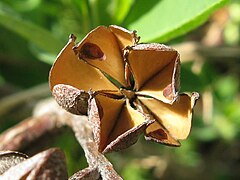| Exochorda | |
|---|---|

| |
| Exochorda korolkowii | |
| Scientific classification | |
| Kingdom: | Plantae |
| Clade: | Tracheophytes |
| Clade: | Angiosperms |
| Clade: | Eudicots |
| Clade: | Rosids |
| Order: | Rosales |
| Family: | Rosaceae |
| Subfamily: | Amygdaloideae |
| Tribe: | Exochordeae |
| Genus: | Exochorda Lindl. |
| Species | |
or only | |
Exochorda /ˌɛksoʊˈkɔːrdə/ is a small genus of flowering plants in the family Rosaceae, native to China and central Asia (Turkestan). They are used as ornamental plants with the common name pearl bush, or pearlbush. Numerous species have been described on the basis of differing appearance and geographical separation, but a systematic study revealed that the different types are closely related and probably all descended from a single species that formerly had a wide distribution that has been fragmented by habitat loss. As a single species the correct name is E. racemosa.
Description
They are deciduous shrubs growing 2–4 m (7–13 ft) tall. The leaves are paddle-shaped oval, 3–9 cm (1–4 in) long, with an entire or bluntly serrated margin. The flowers are white, with five petals, produced in spring on the ends of the branches. The fruit is a dry coccetum consisting of five fused carpels, which split to release the flattened seeds. Lindley wrote in the original description of the genus "The free placentary chords external to the carpels have suggested the name of the genus."
Cultivation
A valuable garden hybrid is known as E. × macrantha C.K.Schneid. or Exochorda 'The Bride'. Lemoine's catalog of 1904 stated "We obtained this hybrid by fertilizing E. alberti with pollen from E. grandiflora. The clusters of flowers which terminate each shoot, are erect or horizontal, each one with 8 to 10 large flowers, well opened and unfolded, snow white. This new shrub has the vigorous growth of E. grandiflora. As an isolated specimen the effect is magnificent." This plant has gained the Royal Horticultural Society's Award of Garden Merit.
Gallery
-
 Leaves
Leaves
-
 E. × macrantha 'The bride', flowers
E. × macrantha 'The bride', flowers
-
 Young fruit
Young fruit
-
 Fully open fruit after the seeds have dispersed
Fully open fruit after the seeds have dispersed
References
- ^ Gao Fangyou. 1998. Exochorda: five species or one?: a biosystematic study of the Rosaceous genus Exochorda. Wageningen University Dissertation published as a book.
- Sunset Western Garden Book, 1995:606–607
- Lindley, J. (1858). New plants. Gardeners' Chronicle. London. 925–925.
- Schneider, C. K. 1905. Illustriertes Handbuch der Laubholzkunde. Charakteristik der in Mitteleuropa heimischen im Freien angepflanzten angiospermen Gehölz-Arten und Formen mit Ausschluss der Bambuseen und Kakteen. Verlag von Gustav Fischer, Jena. Volume 1, pp 493–494 https://www.biodiversitylibrary.org/item/5886
- "Exochorda × macrantha 'The Bride' AGM". Royal Horticultural Society. Retrieved 11 April 2020.
- "AGM Plants - Ornamental" (PDF). Royal Horticultural Society. July 2017. p. 38. Retrieved 26 February 2018.
External links
- Flora of China: Exochorda
- Huxley, A. (1992). The New RHS Dictionary of Gardening 2: 274. Macmillan. ISBN 0-333-77018-8
- Trees & Shrubs, Botanica, 1987, pg. 373. ISBN 0-89586-372-3
- http://www.bbc.co.uk/gardening/plants/plant_finder/plant_pages/310.shtml BBC Gardening Plant Finder
| Taxon identifiers | |
|---|---|
| Exochorda |
|